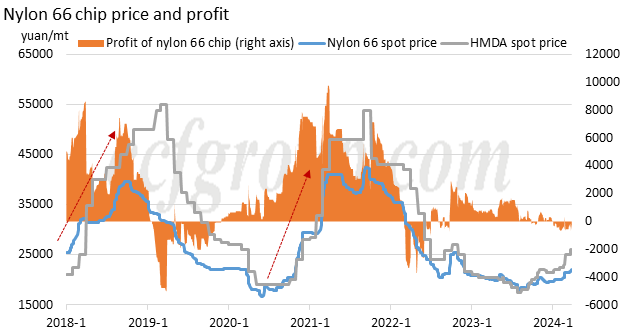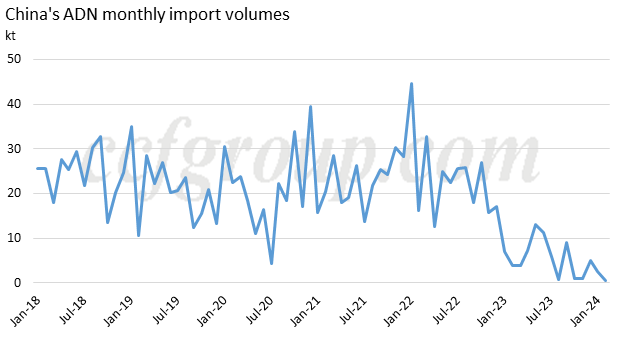Big cycle for nylon 66 coming?
Looking back at the historical price trends of nylon 66 in China, it can be described as a roller coaster ride. The two major price surges in 2018 and 2021 were largely driven by unexpected factors related to adiponitrile and HMDA. In 2018, mainstream manufacturers such as BASF in Germany, Solvay in France, Radici in Italy, Invista, and Ineos announced price increases throughout the year due to force majeure events (related to adiponitrile, HMDA, or nylon 66 facilities being affected by weather, strikes, electrical faults, fires, etc.). Nylon 66 suppliers including Ascend, BASF, Domo, Celanese, Toray and DSM raised chip prices significantly, with highest increase over 40,000yuan/mt. The market trends in 2021 were somewhat similar to those in 2018. Due to a shortage of adiponitrile supply, chip prices surged rapidly from 30,000yuan/mt at the beginning of the year to 42,000yuan/mt by the end of the first quarter, remaining at high levels for about half a year. However, the recovery of adiponitrile supply led to a rapid decline in chip prices later.

From a long-term perspective, we observe that the price fluctuation cycle of nylon 66 is approximately around 3 years. The last time nylon 66 hit bottom was around the middle of 2023, which is quite close to the mid-2020s. Combined with the active price increases of HMDA by mainstream factories in the past six months, there seems to be signs of a resurgence in nylon 66.
However, whether reality will follow the expected trend requires careful analysis of the sources of the two previous price increases and the basis for the current situation. The price increases in 2018 and 2021 were quite similar, with chip prices skyrocketing from below 20,000yuan/mt to over 40,000yuan/mt, primarily driven by adiponitrile. The price trend of nylon 66 is highly consistent with HMDA, while the impact of adipic acid price fluctuations is relatively minor. Before 2021, domestic adiponitrile was largely dependent on imports, with global adiponitrile capacity at around 1.8 million tons, of which Invista, Solvay, Ascend, and BASF accounted for 80%. The high concentration of capacity also meant that the resilience of adiponitrile supply was weak. When a few factories faced supply issues, downstream customers worldwide experienced shortages.
From the middle of 2023 to March 2024, explosions at Invista's Butachimie plant in France and the gradual shutdown of adiponitrile and HMDA facilities at Invista's Orange, Texas plant in the United States can be seen as a series of force majeure events leading to a reduction in adiponitrile supply. However, due to relatively weak overseas demand for nylon 66, the impact of these events has been limited.
With Invista's 400kt/year adiponitrile plant in Shanghai coming online and China domestic companies such as Huafon, Shenma, Ruitai, and Tianchen making significant breakthroughs in adiponitrile and HMDA raw materials, China domestic raw material capacity has exceeded 800kt/year, providing strong support for the existing 900kt/year of nylon 66 capacity in China. Therefore, the strong momentum in HMDA prices in the first quarter of 2024 is more of a reaction to Invista's adiponitrile maintenance plan in the second quarter and whether Tianchen Qixiang can successfully restart in April. However, in terms of secure adiponitrile supply, even without relying on imports, by 2024, China can rely on domestic facilities. Since the commissioning of Invista's adiponitrile plant in Shanghai at the end of 2022, the median import volume of adiponitrile has rapidly declined from around 25,000 tons per month to below 10,000 tons per month. Demand-side polymer plants' operating rate has been relatively stable, with no significant growth in end user's demand seen in 2024, so the variables still mainly lie in the supply of adiponitrile.

The second factor influencing adiponitrile prices is raw material costs. Currently, domestic HMDA prices are dominated by Invista, and the cost advantage of butadiene method is quite evident. The domestic price of butadiene has almost doubled from its low point last year, leading to a significant increase in the cost of butadiene-based adiponitrile, with manufacturers using other process routes following Invista's price increases. However, from a cost perspective, butadiene is unlikely to surpass 15,000, making it quite challenging to push HMDA prices above 30,000yuan/mt solely based on cost support.

In conclusion, the possibility of nylon 66 replicating the craziness of the past is low. The main reason is that the domestic supply of adiponitrile is secure. Since hitting a low point in 2023, the market has essentially weathered factors such as factory explosions, layoffs, shutdowns, and equipment failures, which are considered force majeure. China domestic polymerization plants such as Shenma, Huafon, Ruitai, and Tianchen all have either full or partial self-sufficiency in adiponitrile, significantly enhancing their risk resistance on the supply side compared to 2018 and 2021. Additionally, the limited upside space in cost support has also to some extent constrained the rise of ADN. Of course, the tight supply of ADN in the first half of this year may be difficult to alleviate in the short term. This factor will depend on the successful completion of the maintenance at Invista in the second quarter and the smooth restart of adiponitrile and adipic acid units at Tianchen Qixiang.
- Top keywords
- Cotton Price
- Cotton Futures Price
- Cotton Futures
- CZCE
- PTA Futures Price
- Chemical Fiber
- Polyester Prices
- Wool price
- PTA Futures
- Shengze Silk
- China
- Yarn Price
- price
- China Textile City
- Fibre Price
- Benzene Price
- Cotton
- Index
- Cotton Index
- PTA
- fabric price
- NYMEX
- Top 10
- textile industry
- Spot Cotton
- Cotton Yarn
- Polyester Price
- Futures
- PTA Price
- cotton yarn price

